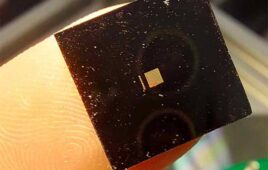
MIT engineers have devised a way to assess a cell’s mechanical properties simply by observation. The researchers use standard confocal microscopy to zero in on the constant, jiggling motions of a cell’s particles. [Image from Jose-Luis Olivares/MIT]
Usually, cells have to be probed with expensive instruments like atomic force microscopes and optical tweezers to determine the mechanical properties of a cell. Those methods make direct and invasive contact with the cells. The new method involves using standard confocal microscopy. Researchers focus on the constant and jiggling motions of cell particles. These movements are able to tell how stiff a cell is.
The mechanical properties of a cell can be an indicator of whether cells are healthy or diseased and can help doctors diagnose the progression of certain diseases.
“There are several diseases, like certain types of cancer and asthma, where stiffness of the cell is known to be linked to the phenotype of the disease,” Ming Guo, assistant professor in MIT’s Department of Mechanical Engineering, said in a press release. “This technique really opens a door so that a medical doctor or biologist, if they would like to know the material property of cell in a very quick, noninvasive way, can now do it.”
Albert Einstein created a formula in 1905 that could be used to observe the mechanical properties of a material and measure the movement of particles in the material. The only downfall of his Stoke-Einstein equation was that the materials had to be in equilibrium, which means the particle motions have to occur from the temperature of the material and not external forces.
“You can think of equilibrium as being a hot cup of coffee,” Guo said. “The coffee’s temperature alone can drive sugar to disperse. Now if you stir the coffee with a spoon, the sugar dissolves faster, but the system is not driven solely by temperature anymore and is no longer in equilibrium. You’re changing the environment, putting energy in and making the reaction happen faster.”
Guo also said that organelles in a cell are constantly moving because of a cell’s temperature, but there are “minispoons” that are stirring in a cell’s cytoplasm. Those are usually proteins and molecules that are pushing the vibrating organelles around like pool balls.
The amount of activity in a cell has made it hard for scientists to observe which motions are from temperature and which are from activity. Because of this, Einstein’s method can’t be used.
Guo and his colleague Satish Kumar Gupta figured out that there may be a way to teach temperature-driven motions in a cell by observing the cell in a narrow timeframe. They discovered that the particles that were energized by temperature were constantly jiggling. Temperature-driven particles were always moving regardless of time. In comparison, the activity that moves particles around in a cell only move occasionally. These cells could be observed over a longer timeframe.
They tested their method on human melanoma cells. Small polymer particles were injected into each cell and the motions were tracked using a standard confocal fluorescent microscope. They also manipulated the stiffness of cells by exposing salt to the cell solution, which tends to draw out water from the cells.
The researchers recorded the cell movements at different frame rates to see how the particles movements changed with stiffness. At frequencies of 10 frames per second or higher, particles jiggled in place and appeared to be caused only by temperature. Slower frame rates showed more active and random movements in the cell with particles going wider distances.
They tracked the path of the particles in the video and used an algorithm they developed to figure out what the average distance the particles traveled was. They used the calculation from their algorithm and applied it to the Stokes-Einstein equation.
Measurements they got from the equation were compared with measurements they got from using optical tweezers. Their calculations were the same when they used the motion of particles that were captured at 10 frames per second or higher, suggesting that [article movements at high frequencies are temperature driven.
“Now if people want to measure the mechanical properties of cells, they can just watch them,” Guo said.
The researchers are working with Massachusetts General hospital doctors to use the new technique to study cancer, asthma and other conditions.
“People have an idea that structure changes, but doctors want to use this method to demonstrate whether there is a change, and whether we can use this to diagnose these conditions,” Guo said.
The research was funded by MIT’s department of mechanical engineering and was published in the Journal of the Mechanics and Physics of Solids.




